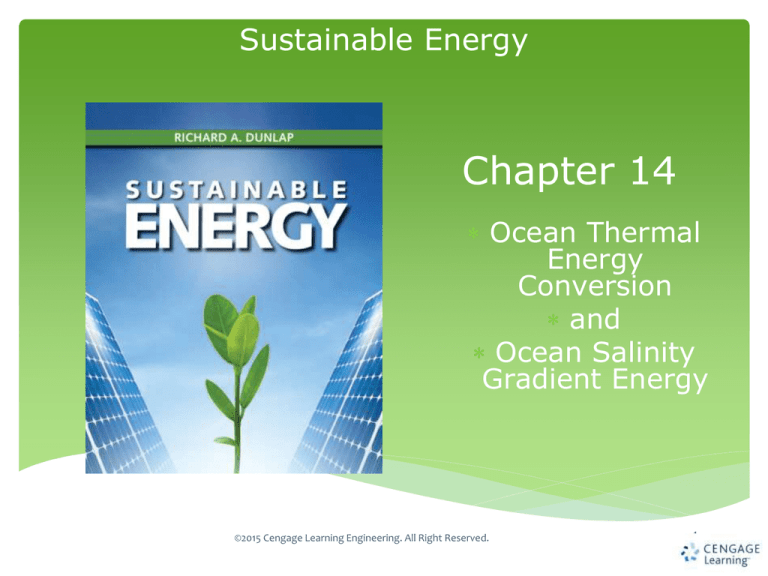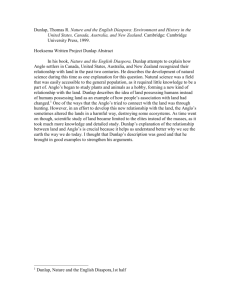
Sustainable Energy
Chapter 14
Ocean Thermal
Energy
Conversion
and
Ocean Salinity
Gradient Energy
©2015 Cengage Learning Engineering. All Right Reserved.
1
Sustainable Energy
Dunlap
Learning Objectives
●
●
●
●
●
●
The distribution of thermal energy in the oceans.
The use of a heat engine to extract energy from
the oceans and convert it into electricity.
The design of the different types of OTEC systems.
Experimental OTEC facilities and their
performance.
The basic principles of osmotic energy
production.
Experimental facilities for osmotic energy
production.
©2015 Cengage Learning Engineering. All Right Reserved.
2
Sustainable Energy
Dunlap
Basics of Ocean Thermal Energy
Conversion (OTEC)
A heat engine may be constructed using the temperature
difference between the cold water deep in the ocean and the
warm surface water.
Below about 1000 m depth ocean water is a fairly constant
temperature of about 4 °C.
To maximize efficiency of heat engine it is necessary to
maximize the temperature difference.
This means maximizing the surface temperature - so tropical
regions are appropriate.
©2015 Cengage Learning Engineering. All Right Reserved.
3
Depth dependence of ocean
temperature
Sustainable Energy
typical thermocline in tropical regions
©2015 Cengage Learning Engineering. All Right Reserved.
4
Dunlap
Sustainable Energy
Dunlap
Ocean surface temperature worldwide
©2015 Cengage Learning Engineering. All Right Reserved.
5
Sustainable Energy
Dunlap
Types of OTEC systems
Three different systems designs exist
• Open cycle
• Closed cycle
• Hybrid systems
©2015 Cengage Learning Engineering. All Right Reserved.
6
Sustainable Energy
Dunlap
Open cycle OTEC system design
©2015 Cengage Learning Engineering. All Right Reserved.
7
Sustainable Energy
Dunlap
Operation of an open cycle OTEC system
Warm surface water is vaporized in the evaporator
by lowering its vapor pressure.
The vaporized water is used to run a turbine and
is then condensed by cooling it with cold sea
water pumped from deep in the ocean.
©2015 Cengage Learning Engineering. All Right Reserved.
8
Sustainable Energy
Dunlap
Phase diagram of water
Above the triple point, lowering the pressure causes a
transition from the liquid to gaseous state - This is what
happens in the evaporator.
Lowering the temperature of a gas causes a transition back to
the liquid state - This is what happen in the condenser.
©2015 Cengage Learning Engineering. All Right Reserved.
9
Sustainable Energy
Dunlap
Closed cycle OTEC system
A closed cycle OTEC system uses a working fluid (other than
water) to drive the turbine.
Heat is transferred to the working fluid by a heat exchanger
(evaporator).
Heat is extracted from the working fluid by a heat
exchanger.
©2015 Cengage Learning Engineering. All Right Reserved.
10
Sustainable Energy
Dunlap
Schematic of a closed cycle OTEC system
©2015 Cengage Learning Engineering. All Right Reserved.
11
Sustainable Energy
Dunlap
Hybrid OTEC systems
Hybrid systems vaporize both the warm sea
water and the working fluid.
The vaporized working fluid is used to drive
the turbine.
The vaporized sea water is condensed to
provide a source of fresh water.
©2015 Cengage Learning Engineering. All Right Reserved.
12
Sustainable Energy
Dunlap
Analysis of OTEC energy output
The thermal energy available is the difference in thermal
energy associated with warm water and the cold water.
The mechanical energy is the available thermal energy
times the Carnot efficiency of the heat engine.
The Carnot efficiency is determined by the absolute
temperature difference between the evaporator and
condenser.
The electrical energy is the mechanical energy times the
efficiency of the generator (high).
©2015 Cengage Learning Engineering. All Right Reserved.
13
Sustainable Energy
Dunlap
Comparison with coal fired generating station
The thermal energy available in a coal fired generating
station is the energy produced by the combustion of the
coal.
The mechanical energy is the available thermal energy
times the Carnot efficiency of the heat engine.
The Carnot efficiency is determined by the absolute
temperature difference between the boiler and the cold
reservoir.
The electrical energy is the mechanical energy times the
efficiency of the generator (high).
©2015 Cengage Learning Engineering. All Right Reserved.
14
Sustainable Energy
Dunlap
Limitations of OTEC
Compared to the coal generating station the energy output of
the OTEC system is affected by the following factors:
• Small available energy due to small temperature
differences between the warm and cold seawater
• Low Carnot efficiencies due to small temperature
differences between evaporator and condenser
• Net energy also reduced because of large amount of
energy needed to pump seawater from deep in the ocean
©2015 Cengage Learning Engineering. All Right Reserved.
15
Sustainable Energy
Dunlap
An experimental OTEC facility
Keahole Point, Hawaii
©2015 Cengage Learning Engineering. All Right Reserved.
16
Sustainable Energy
Dunlap
OTEC facility locations
Facilities may be
• on (or near) shore in which case cold water will need to
be pumped onshore
• offshore in which case electricity will need to be
transported onshore
Success limited by
• Low efficiencies
• Complications due to adverse marine environment
• Transport of electricity to users
©2015 Cengage Learning Engineering. All Right Reserved.
17
Sustainable Energy
Dunlap
1980 prediction of OTEC capacity
©2015 Cengage Learning Engineering. All Right Reserved.
18
Sustainable Energy
Dunlap
Actual OTEC capacity
No current commercial OTEC energy production
May be most useful as a source of
• fresh water for domestic use
• cold water to replace air conditioning
©2015 Cengage Learning Engineering. All Right Reserved.
19
Sustainable Energy
Dunlap
Ocean salinity gradient energy
Two solutions (i.e. salt water and fresh water) are
separated by a membrane that allows the flow of water but
not the solutes.
Driving force tries to equals concentration gradients by
allowing water to flow from the concentrated side to the
dilute side.
©2015 Cengage Learning Engineering. All Right Reserved.
20
Sustainable Energy
Dunlap
Osmotic cell
Driving force cases height difference on the two sides of
the membrane
©2015 Cengage Learning Engineering. All Right Reserved.
21
Sustainable Energy
Dunlap
Osmotic pressure
The osmotic pressure is
i = solute dependent constant (2.0 for NaCl)
R = gas constant
M = molarity
T = temperature
Pressure is related to gravitational force due to height
difference (d) across the membrane is
©2015 Cengage Learning Engineering. All Right Reserved.
22
Sustainable Energy
Dunlap
Production of electricity from osmotic
pressure
Two approaches:
• pressure retarded osmosis (PRO)
• reverse electrodialysis (RED)
©2015 Cengage Learning Engineering. All Right Reserved.
23
Sustainable Energy
Dunlap
Pressure retarded osmosis
Water flowing across the membrane is used to
drive turbines (to generate electricity) so as to
keep the height on both sides of the
membrane approximately equal.
©2015 Cengage Learning Engineering. All Right Reserved.
24
Sustainable Energy
Reverse electrodialysis
Charges associated with the dissolved ions contribute
directly to the flow of current
©2015 Cengage Learning Engineering. All Right Reserved.
25
Dunlap
Sustainable Energy
Dunlap
Applications of osmotic energy
Potential viability where sources of seawater (ocean) and
fresh water are in proximity
(i.e. mouths of large rivers that empty into the sea)
No commercial applications at present
Economic viability remains to be determined
©2015 Cengage Learning Engineering. All Right Reserved.
26
Sustainable Energy
Dunlap
Pilot PRO facility in Norway
©2015 Cengage Learning Engineering. All Right Reserved.
27
Sustainable Energy
Dunlap
Summary
• Energy can be obtained from the temperature gradients in
the oceans and converted into electricity
• The small temperature difference combined with low Carnot
efficiency make this approach difficult.
• Ocean salinity gradient available where large rivers empty
into the ocean.
• Two approaches:
o Pressure retarded osmosis
o Reverse electrodialysis
• Viability of both OTEC and salinity gradient technologies
needs to be established
©2015 Cengage Learning Engineering. All Right Reserved.
28



